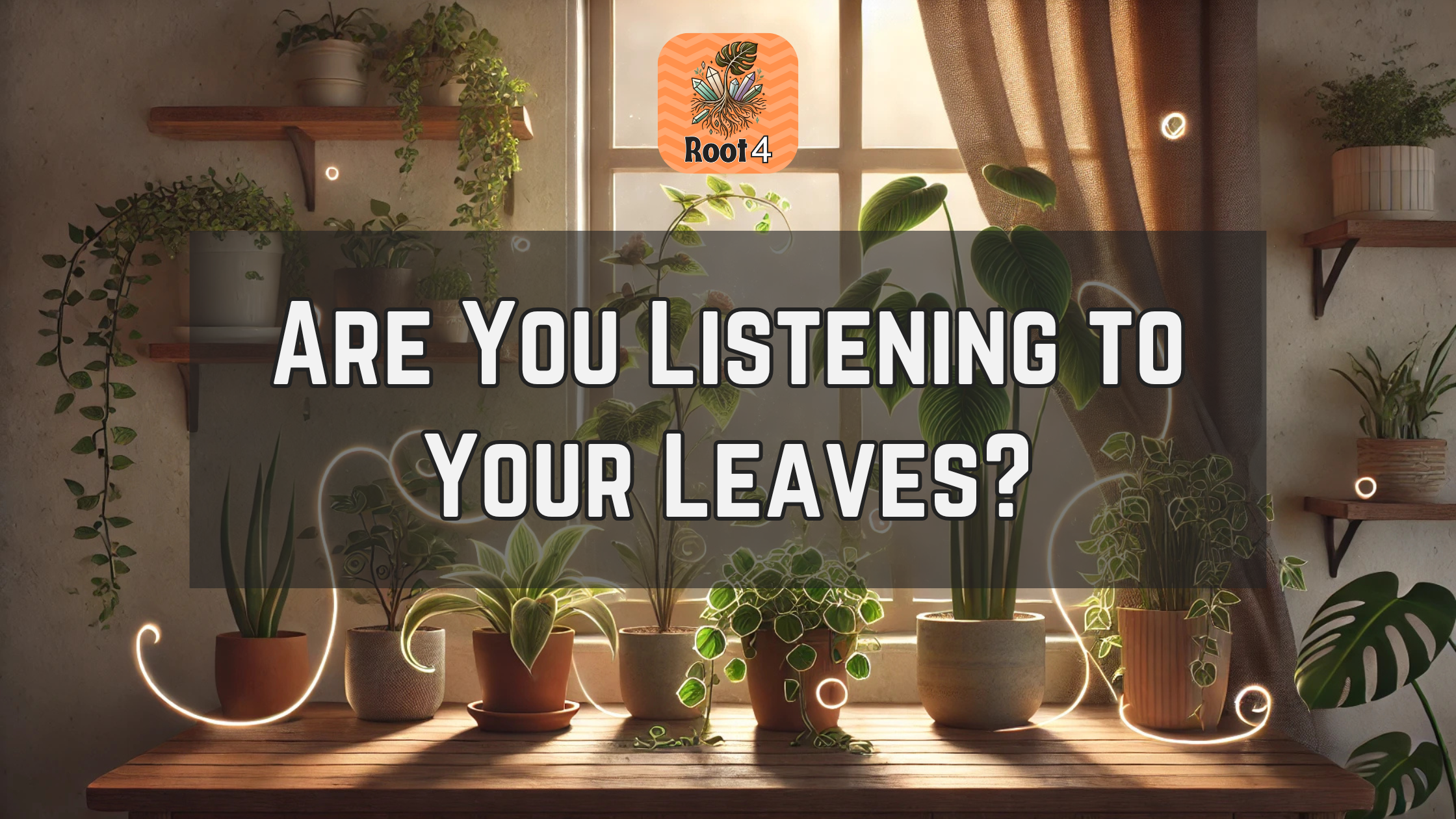Your cart is currently empty!

Are You Listening to Your Leaves?
At Root 4, we believe nature has a rhythm—and when you slow down enough to tune in, you start to notice the ways your plants are already speaking. One of the most powerful tools in plant care isn’t a watering can or moisture meter—it’s your attention.
Plants may not use words, but they’re expressive beings. Their leaves shift, curl, sag, or stand tall depending on how they’re feeling. Once you start watching closely, you’ll see: they’re always telling you something.
Leaves as Language
A plant’s leaves are like a built-in communication system. One of the clearest messages they send? “I’m thirsty.”
Here are some great examples of plants that show clear signs when they’re in need of water:
- Prayer Plants (Maranta, Calathea, and similar) – These beauties are incredibly expressive. When hydrated and happy, their leaves lay flat and open wide during the day. If they’re feeling dry or stressed, they start to curl inward or droop—like they’re closing up in prayer. They’ll often perk back up overnight once watered.
- Pothos – A classic beginner-friendly plant with easy-to-read signs. When thirsty, its once-perky vines begin to droop, and the leaves may look a bit deflated. Water it, and it often perks up within hours—an instant reward for paying attention.
- Peperomias – With their thick, waxy leaves, these plants don’t wilt dramatically—but they do talk. When thirsty, you’ll notice the leaves feel less firm and start to sag just slightly. It’s subtle but consistent.
- Philodendrons – Their leaves start to curl inward and may look slightly shrunken when thirsty. They don’t always droop, so watch for curling and dryness in the soil.
- Pitcher Plants – These carnivorous plants will show wrinkling on their pitchers and sometimes on the leaves when they need water or higher humidity. It’s a soft cue, but noticeable once you’ve seen it.
- Peace Lilies – Known for their dramatic wilt, peace lilies collapse entirely when they’re dry—but bounce back fast after a drink. Just don’t let them hit that point too often, as it can stress the plant over time.
- Spider Plants – Look for leaves that start to bend or crease near the base. When thirsty, they lose their spring and begin to droop downward.
- Fittonia (Nerve Plant) – Another drama queen. Fittonia plants flop over dramatically when they’re dry, but revive quickly after watering. It’s a striking signal that’s easy to learn from.
- Fiddle Leaf Fig – These popular plants can be fussy, but they’ll let you know when they need water. Look for slight inward curling on the edges and a dull appearance on their usually glossy leaves.
- Alocasia – Leaves will start to droop, and the stems may feel soft or bendy near the base when thirsty. These plants are a bit more sensitive, so timing is key.
Observation Over Routine
Instead of watering on a rigid schedule, try forming a habit of observation. Every plant lives in its own little ecosystem—impacted by light, temperature, airflow, pot size, and season. Learning your plant’s individual rhythm is far more reliable than any one-size-fits-all calendar.
Try asking yourself:
- Are the leaves standing tall or starting to sag?
- Do you notice any curling, spotting, or color shift?
- What does the soil feel like—dry, damp, compacted, or cool?
Over time, you’ll begin catching the early signals before your plant gets droopy or distressed. That’s when you know you’ve started to understand their language.
It’s a Conversation
Caring for plants is more than a chore—it’s a relationship. When you start noticing how your plant “talks,” you build a rhythm together. You observe, respond, and in turn, your plant grows healthier and more vibrant.
So next time you pass your pothos, glance at your prayer plant, or notice a slight curl in your philodendron, pause and ask:
Are you listening to your leaves?
Keep Growing Your Connection
Learning to listen to your plants takes time, but it’s one of the most rewarding parts of plant care. The more you observe, the more confident you’ll feel. And soon enough, you’ll catch yourself noticing even the smallest shifts—like a leaf angling toward the light or a subtle change in texture.
It’s in those quiet moments—checking soil with your fingertips, watching new growth unfurl, or seeing a droopy plant perk up—that you realize plant care isn’t just about keeping something alive. It’s about deepening your awareness. About tuning in. About remembering that nature speaks, even indoors.
At Root 4, we’re all about cultivating that connection. Whether you’re just starting your plant journey or growing a full jungle at home, we’re here to help you tune in and thrive alongside your plants.

Leave a Reply